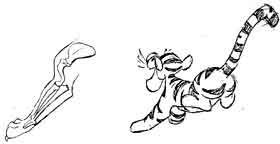Because animation, despite the technological advances of CGI these days, still doesn’t quite mimic the reality of emotion on a character unlike a live action piece could, exaggeration is used to characterise it. There needs to be an element of balance within it to avoid too unrealistic actions, comedy when not intended or just general “over animating”, but if done well the audience understands the emotion as it is intended.
The example of exaggeration using Cartoon Network’s Road Runner and Coyote demonstrates the use of exaggeration where appropriate for its intention. The frantic leg spinning of the chasing Coyote, the smoke billowing from the feet of the Road runner, the coyotes tongue hanging out and his eyes bulging in excitement of catching his prey creates the comical element the makers were after, where as if Cartoon Network hadn’t exaggerated and decided to be as realistic as possible, well… that would be just down right boring and seemingly emotionless on both character parts.










